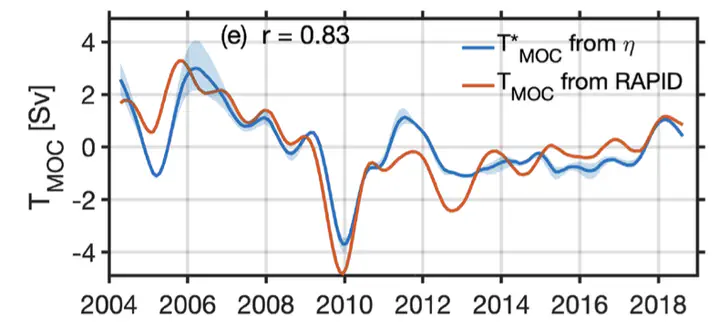A dynamically based method for estimating the Atlantic meridional overturning circulation at 26°N from satellite altimetry
 RAPID MOC transport (TMOC; orange line) and the satellite-based T ∗ transport estimates as per Eq. (19) (blue line).
RAPID MOC transport (TMOC; orange line) and the satellite-based T ∗ transport estimates as per Eq. (19) (blue line).
Abstract
The large-scale system of ocean currents that transport warm waters in the upper 1000 m northward and return deeper cooler waters southward is known as the At- lantic meridional overturning circulation (AMOC). Varia- tions in the AMOC have significant repercussions for the climate system; hence, there is a need for long-term moni- toring of AMOC fluctuations. Currently the longest record of continuous directly measured AMOC changes is from the RAPID-MOCHA-WBTS programme, initiated in 2004. The RAPID programme and other mooring programmes have revolutionised our understanding of large-scale circulation; however, by design they are constrained to measurements at a single latitude and cannot tell us anything pre-2004. Nearly global coverage of surface ocean data from satel- lite altimetry has been available since the launch of the TOPEX/Poseidon satellite in 1992 and has been shown to provide reliable estimates of surface ocean transports on in- terannual timescales including previous studies that have in- vestigated empirical correlations between sea surface height variability and the overturning circulation. Here we show a direct calculation of ocean circulation from satellite altime- try of the upper mid-ocean transport (UMO), the Gulf Stream transport through the Florida Straits (GS), and the AMOC using a dynamically based method that combines geostrophy with a time mean of the vertical structure of the flow from the 26◦ N RAPID moorings. The satellite-based transport cap- tures 56%, 49%, and 69% of the UMO, GS, and AMOC transport variability, respectively, from the 26$^∘$N RAPID array on interannual (18-month) timescales. Further investi- gation into the vertical structure of the horizontal transport shows that the first baroclinic mode accounts for 83% of the interior geostrophic variability, and the combined barotropic and first baroclinic mode representation of dynamic height accounts for 98% of the variability. Finally, the methods developed here are used to reconstruct the UMO and the AMOC for the time period pre-dating RAPID, 1993 to 2003. The effective implementation of satellite-based method for monitoring the AMOC at 26$^∘$N lays down the starting point for monitoring large-scale circulation at all latitudes.